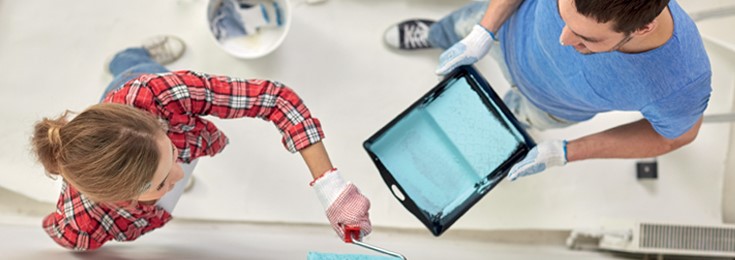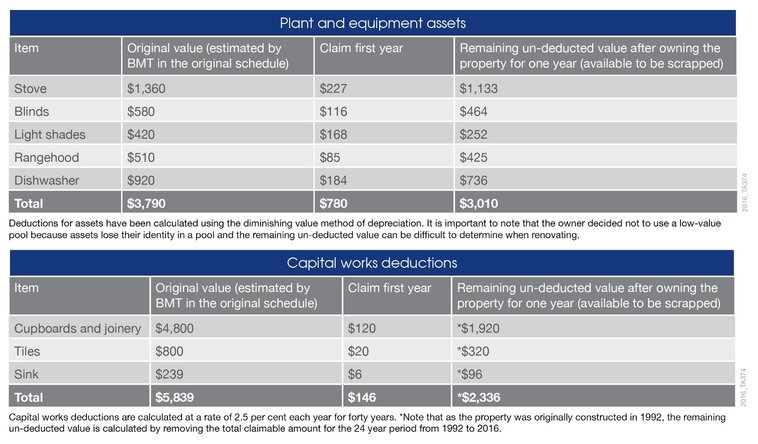31st July 2016
Maximise Tax Deductions when Renovating

ENSURE YOU MAXIMISE YOUR TAX DEDUCTIONS WHEN RENOVATING
Don't be strapped for cash, scrap for cash
Add value and increase deductions when renovating
Australians have always had a passion for renovating property and recent predictions on renovation spending for 2016 suggest this trend will continue.
Data from the Commonwealth Bank Future Home Insights Series forecasts that renovation spending will top $32 billion in 2016 alone. This equates to 36 per cent of total spending on residential construction for detached houses including alterations and additions.
Similarly, a report from the Housing Industry Association estimated that around 213,000 kitchens and 429,400 bathrooms were installed in Australia during the 2015-2016 financial year.
While these predictions demonstrate that owners are not afraid to spend money to improve the value of their homes and rental properties, often property investors may not be aware of the implications that renovations will have on their depreciation deductions.
Whether an investor updates a kitchen, bathroom or simply replaces the carpets or hot water system in a property, the removal of these assets will affect a depreciation claim.
Renovations affect depreciation deductions in two ways. Firstly, an investor should note that any items removed may have a remaining un-deducted depreciable value which they are entitled to claim when the item is removed.
This process, known as scrapping, allows investors to claim the total remaining depreciable value for items which are thrown away in the year of their removal.
Investors must also factor in deductions they can claim for new items they add to the property.
Assets will be captured by a depreciation specialist during a pre-renovation inspection. After the renovation is completed, a new depreciation schedule is then prepared listing all new additions that have been added and the existing depreciable items which will remain in the property.
To show how depreciation deductions are affected during a renovation, let's look at the following example.
An investor purchased a property one year ago. Originally constructed in 1992, the property was beginning to show signs of wear and tear.
Upon purchase, the investor rented out the property and engaged BMT Tax Depreciation to prepare a depreciation schedule. After owning the property for twelve months, the investor decided to install a new kitchen to improve future rental income and increase the equity held in the property.
Outlined in the owner's original existing depreciation schedule were items discovered during the first site inspection including a stove, blinds, light fittings, a rangehood, a dishwasher, a sink, tiled floors, cupboards and joinery.
The tables below show the original value of items and the depreciation deductions that could be claimed in the first full financial year. They also show the remaining un-deducted value of items after the first year's claim was made.

This investor could claim $780 for plant and equipment depreciation and $146 in capital works deductions, a combined total depreciation deduction of $926 in the first full financial year for the kitchen alone.
They can also claim the remaining un-deducted value of $3,010 for plant and equipment and $2,336 for capital works for items removed and scrapped during the renovation in the financial year of their removal.
BMT found that the newly installed kitchen would result in $1,611 in deductions for the owner in the year it is installed. Therefore a total of $6,957 could be claimed for the removed assets and the depreciation of the new kitchen.
Additional depreciation deductions are also available for structures and assets found in the rest of the property.
To avoid throwing thousands of dollars away in existing items and to ensure deductions for new items are captured it is essential to speak to a Quantity Surveyor before you start your renovation.
Article provided by BMT Tax Depreciation originally published
online at
www.bmtqs.com.au/maverick/mav-40-dont-be-strapped-for-cash-scrap-for-cash/
Bradley Beer (B. Con. Mgt, AAIQS,
MRICS, AVAA) is the Chief Executive Officer of BMT Tax Depreciation.
Please contact 1300 728 726 or visit www.bmtqs.com.au for an Australia-wide service.
©2026 Cale Property Agents |Privacy Policy |Disclaimer | Sitemap| Marketing byReal Estate Australiaand ReNetReal Estate Software

